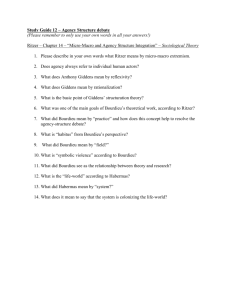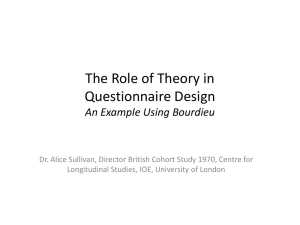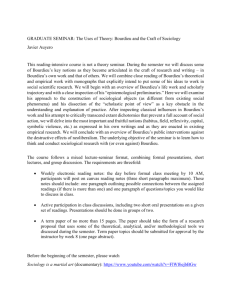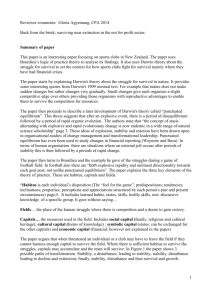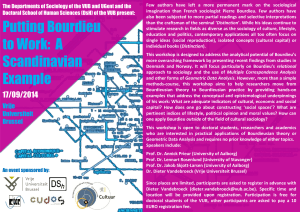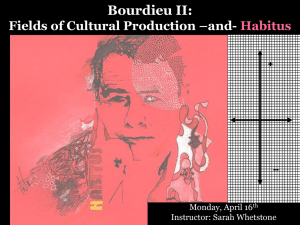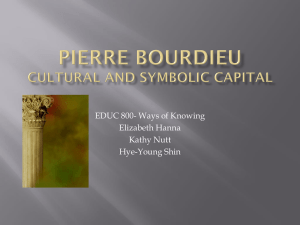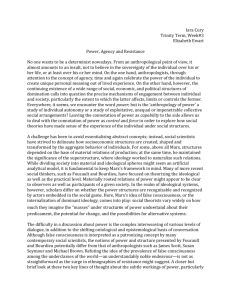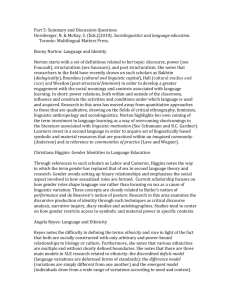Examining Inter-Space - Lancaster University
advertisement
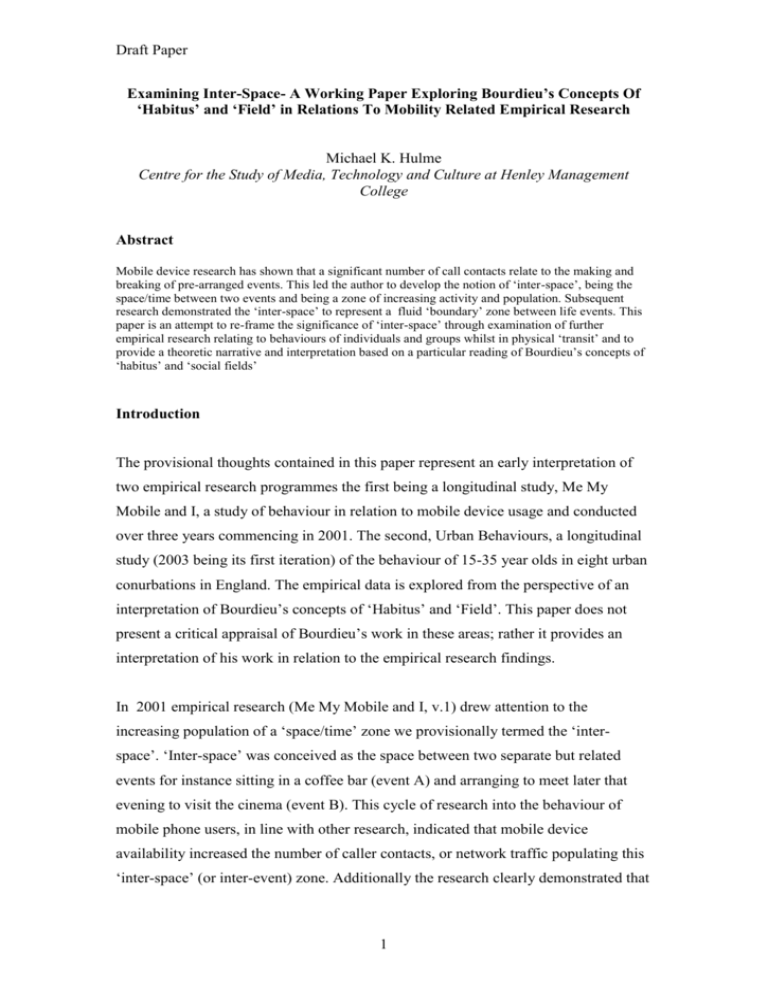
Draft Paper Examining Inter-Space- A Working Paper Exploring Bourdieu’s Concepts Of ‘Habitus’ and ‘Field’ in Relations To Mobility Related Empirical Research Michael K. Hulme Centre for the Study of Media, Technology and Culture at Henley Management College Abstract Mobile device research has shown that a significant number of call contacts relate to the making and breaking of pre-arranged events. This led the author to develop the notion of ‘inter-space’, being the space/time between two events and being a zone of increasing activity and population. Subsequent research demonstrated the ‘inter-space’ to represent a fluid ‘boundary’ zone between life events. This paper is an attempt to re-frame the significance of ‘inter-space’ through examination of further empirical research relating to behaviours of individuals and groups whilst in physical ‘transit’ and to provide a theoretic narrative and interpretation based on a particular reading of Bourdieu’s concepts of ‘habitus’ and ‘social fields’ Introduction The provisional thoughts contained in this paper represent an early interpretation of two empirical research programmes the first being a longitudinal study, Me My Mobile and I, a study of behaviour in relation to mobile device usage and conducted over three years commencing in 2001. The second, Urban Behaviours, a longitudinal study (2003 being its first iteration) of the behaviour of 15-35 year olds in eight urban conurbations in England. The empirical data is explored from the perspective of an interpretation of Bourdieu’s concepts of ‘Habitus’ and ‘Field’. This paper does not present a critical appraisal of Bourdieu’s work in these areas; rather it provides an interpretation of his work in relation to the empirical research findings. In 2001 empirical research (Me My Mobile and I, v.1) drew attention to the increasing population of a ‘space/time’ zone we provisionally termed the ‘interspace’. ‘Inter-space’ was conceived as the space between two separate but related events for instance sitting in a coffee bar (event A) and arranging to meet later that evening to visit the cinema (event B). This cycle of research into the behaviour of mobile phone users, in line with other research, indicated that mobile device availability increased the number of caller contacts, or network traffic populating this ‘inter-space’ (or inter-event) zone. Additionally the research clearly demonstrated that 1 Draft Paper the rapidly increasing use of SMS far from replacing voice calls was operating in addition to voice to increase the number of call contacts overall. A later version of the research (Me My Mobile and v.3) in 2003 demonstrated that a significant element of usage was related to organising/disorganising future committed events. Much contact traffic was related to and took place in the ‘inter-space’ between, at its most simplistic level, events A and B. This led us to suggest that in certain circumstances the ‘interspace’ zone, between A and B could be more important than the actual events. Clearly this ‘transit space ‘ was significantly important but was not a space discussed in most studies. Much mobile behaviour/device related research to this point had concentrated on the actions of the individual within spaces i.e. private behaviour in public spaces (Cooper, 2002) rather than the configuration and reconfigurations of spaces mediated through mobile devices, although research by several authors including Virilio (2000) did draw attention to this broad area. The Urban Behaviours (2003) research programme was designed to explore ‘lifestyle’ issues for 15-35 year olds. Emerging from this was a series of space/time/value definitions around notions of home, social and work spaces. These simple groupings were self-defined by the sample during the qualitative stage of the research. Later, drawing from the quantitative strand of the research, statistical based typologies were developed exploring the relative importance of home, social and work spaces, these typologies were categorised as Homeostatic, Work Homeodynamic, Social Homeodynamic, Home Homeodynamic and Dual Homedynamic. Each group represents a ‘preponderant tendency’ towards an identifiable range of behaviours. Analysis of these findings drew increasing attention to the means by which each space was sustained by the individual, particularly during periods outside the dominant space, either in a weaker space or in transit between spaces, for example travel to work from a home space to a work space where the work space has dominance (Work Homeodynamic characteristics). It was realised that the original notion of ‘interspace’ rising from the earlier mobile work offered interesting possibilities for analysis of this new data. In particular it appeared to demonstrate that the ‘forces’ or ‘fields’ of the predominant spaces might significantly act upon the weaker spaces even when the individual is fully engaged in the weaker space. In this manner the ‘inter-space’ between A and B may increase in significance as it may be used to re-enforce the dominant space. These lines of thought also drew us to consider ideas of power or 2 Draft Paper ‘fields’ in relation to mobile or transitional states and to ask the question to what extent are mobile or transitional states configured and reconfigured in relation to dominant spaces? Here mobility or transit would encompass physical transit, mental/emotional and social mobilities. This line of enquiry was facilitated by further data from the Urban Behaviours research examining physical travel, times spent in transit and occupations during transit between the three broadly defined space sets (figure one). Figure 1- ‘Inter-space’ as boundary ‘Habitus’ and ‘Fields’ Bourdieu stresses the importance of combining empirical data and theory to the social researcher ‘theory without empirical research is empty. Empirical research without theory is blind’ (Bourdieu, 1988). It is in this spirit that we believe Bourdieu’s research and cultural theory of action around the concepts of ‘Habitus’ and ‘Field’ represent a particularly fruitful explanatory basis from which to consider the empirical data from the two research platforms. The interpretation of these two concepts adopted in this paper see Bourdieu’s central agenda as examining how action is regulated, follows statistical patterns, without being held to some external structure or subjective intention and without a necessary conscious reflection on structures (Swartz, 1997). In this manner Bourdieu (1990) 3 Draft Paper states `I can say that all of my thinking started from this point: how can behaviour be regulated without being the product of obedience to rules?’ This can be restated as an attempt to break away from, or transcend, any form of subjectivist/objectivist dichotomy (Jenkins, 2002). Bourdieus concentration on ‘social practice’ emphasises his interest in what individuals do in their daily lives, he sees social reality as existing in both individuals and in things, therefore in keeping with his desire to break with the subjectivist/objectivist dichotomy he neither believes that behaviours can be understood from the perspective of individual decision making or from some form of deterministic supra-individual ‘structure. Bourdieu (1980) sees that ‘the socialised body (which one calls the individual or person) does not stand in opposition to society; it is one of its forms of existence’. This could be called adopting an ‘action’ orientated position. Bourdieu’s concept of ‘action as strategy’ is fundamental to his position. ‘To substitute strategy for the rule is to reintroduce time, its rhythm, its orientation, its irreversibility’ (Bourdieu, 1977), a concept central to our interpretation of the research data, spaces are here seen as a fusion of physical/emotional and temporal space made manifest through located action. However action is, whilst not deterministic, at least informed by ‘strategies’ of power in relationship to context, environment and the individual. Anxious to challenge a structuralist, rule based approach Bourdieu’s concept of strategy introduces the notion that ‘actors’ in everyday practice (or action) move through a plethora of constraints and opportunities that are grasped imperfectly through time and past experience (Swartz) It is against this background Bourdieu develops the conceptual tool of ‘habitus’ and its closely related concept, ‘field’. ‘Habitus’ was defined and redefined by Bourdieu on many occasions; conceptually it is not without its problems, not least of all in its capacity to handle change. In 1980 Bourdieu defined ‘habitus’ as ‘a system of durable, transposable, dispositions, structured structures predisposed to function as structuring structures, that is as principles which generate and organise practices and representations that can be objectively adapted to their outcomes without presupposing a conscious aiming at ends or an express mastery of the operations necessary in order to attain them’ (Bourdieu, 1990). Central to this concept is the notion of deeply internalised dispositions that have a direct, strategic influence upon action, indeed are one and the same with action. Bourdieu tended to see many of these ‘dispositions’ as being ‘laid 4 Draft Paper down’ at an early stage of socialisation and as such represent potentialities, what is possible or unlikely for particular social groups, in this way ‘habitus ‘ may be seen to set limits for actions (although these may not be conscious) whilst on the other hand may set perceptions and aspirations. In other words ‘habitus’ can be seen to set limits upon agency, not in a rule based structural sense but rather as some deep-structuring cultural matrix (Swartz). Importantly ‘habitus’ is linked with what is practically achievable, encouraging actors to adopt forms of conduct likely to be successful based on past experience and current resources ‘practical evaluation of the likelihood of the success of a given action in a given situation’ (Bourdieu, 1977). However ‘habitus’ is seen as operating through its analogical transfers, or its ‘generative schemes’ in all areas of life. Indeed Bourdieu (1989) suggests an analogy with handwriting, a form of ‘stylistic affinity’ for each individual that operates regardless of form or materiality. ‘Habitus’ is seen in this reading as extended and representing deep rooted ‘dispositions’ that operate only through and by interaction with events and actions, manifesting itself in choices (the roots of which are not wholly conscious) and the identification of opportunities and strategies. Bourdieu (1980) states that ‘field’ means ‘a certain distribution structure of some kind of capital’. ‘Fields’ represent a social space or arena within which struggles or manoeuvres take place over specific resources or stakes and access to them (Jenkins). For Bourdieu ‘fields’ have some degree of structure, a structure organised around types or combinations of capital, they interrelate to produce ‘fields of power’. This key concept is understood primarily through relationships and relational effects ‘to think in terms of field is to think relationally’ (Bourdieu and Wacquant, 1992). In introducing this concept Bourdieu is seeking to go beyond more observable phenomena, to encourage the researcher to consider that which is not visible, for example the concept challenges many notions of ‘context’, notions that tend to be constructed based on sets of observable phenomena re-ordered by the interpreter. It is an ‘active’ theory in that it attempts to explore actions from a dynamic or conflictual character, viewing social life as primarily a series of conflicting elements set in power relationships. Bourdieu employs a very wide definition of field. This extension is developed further by Bauman (2001) when he suggests that all social fields are ‘sedimentations of past power struggles’ and only maintain their ‘shape’ through continuing power struggles. In going beyond ‘defined’ institutions as fields Bourdieu 5 Draft Paper draws specific attention to the difficulty of defining limits to ‘fields’, he uses the ‘broadest possible range of factors that shape behaviour rather than delimit a precise area of activity’ (Swartz) in so doing the boundaries of particular ‘fields’ are not seen as in any way precise. Indeed the boundaries of ‘fields’ may themselves represent particular areas of struggle within a wider view of competing forces. Bourdieu maintains that ‘fields’ have particular properties, arguing that there are ‘invariant laws’ or ‘structural mechanisms’ (Bourdieu, 1993) that are structural properties or characteristics of all ‘fields’. They are seen as arenas in which a struggle for control of resource takes place, these resources Bourdieu sees as capitaleconomic, cultural, scientific or religious. At one level of reading this would be to state that there could be as many forms of ‘field’ as there are forms of capital. However this may be to take a simplistic view of capital, a further reading could see capital itself taken as complex and variable constructions of what can be defined as fundamental elements of capital. Such a reading would lead to a more complex and composite notion of ‘fields’ with the structure of the field very closely linked to its active apprehension. Indeed Bourdieu demonstrates that actors struggle over what can be considered as valued resources (capital) this struggle will only be resolved in action. Positions within ‘fields’ are held to be ‘tightly coupled’ any change in position shifts the boundaries amongst the other positions. ‘Fields’ impose upon actors specific forms of behaviour or struggle, stated simplistically there are rules to any game. ‘Fields’ are to a large extent seen to be internally structured in as much as they possess ‘relative autonomy’, however this not to claim some form of disconnected status. Indeed Bourdieu conceptualises the relations between such relatively autonomous fields as ‘structural and functional homologies, ‘ which defines as ‘resemblance within difference’ (Bourdieu and Wacquant, 1992). Bourdieu writes at length upon homology, however of particular interest to this piece is his explorations into dominant and recessive positions, whereby individuals or groups who find themselves dominant in the struggle for legitimation (or representation) in one field tend to find themselves in subordinate positions in other fields. This line appears to be in close accord with our empirical studies, all be it that the ‘fields’ explored in the research are perhaps best conceived as meta-fields. 6 Draft Paper The relationship between ‘habitus’ and ‘field’ is interlinked, with ‘habitus’ as the ‘unifying principle of practices in different domains’ (Bourdieu, 1977), which can be restated as ‘the space of social positions is retranslated into a space of position-takings through the mediation of the space of dispositions (or habitus)’ (Bourdieu, 1998). Jenkins (1996) commenting on ‘habitus’ as a ‘corpus of dispositions’, observes that the ‘habitus’ model only works in the context of social ‘fields’ and that ‘one seems to flow into and out of the other’. This model of practice sees practice as the outcome of the relationship between ‘habitus’, capital and field. Importantly practices are seen as growing out of the dynamic power interrelationship between ‘habitus’ and ‘field’. It is this aspect of his work and its relationship to ‘field’ boundaries that appears to offer particular value in considering the findings of the empirical research. Empirical Findings As explained earlier the original idea behind the ‘inter-space’ concept was to explain the manner in which the space/time between to events (A and B) was increasingly becoming a valued part of behavioural experience. Later research (Me My Mobile and I, v.3) provided specific evidence in support of the importance of ‘inter-space’ in the 90% 80% 70% 60% 50% 40% 30% 20% 10% 0% M a ke Arra nge Alte r Arra nge F ill in tim e Go s s ip S ho rt m e s s a ge C o nve rs e Lift m o o d Ente rta in Lo c a tio n S e nt 86% 76% 55% 52% 70% 34% 46% 46% 40% R e c e ive d 85% 79% 53% 52% 63% 37% 43% 45% 47% Figure 2 – SMS Usage making and breaking of future arrangements (B events). An examination of SMS use (figure 2) clearly demonstrates the importance of this form of communication in the 7 Draft Paper making and altering of events. SMS was not a technology generally available as little as five years ago; the technology therefore plays a new and key role in facilitating activity within ‘inter-space’. Whilst considering the new role played by mobile communication devices in this ‘transit’ space/time (this is only a transit mode between two particular A to B transactions) we realised that the simple account provided so far required further development and more research data. The Urban Behaviours research project primarily examined lifestyle issue in the 15-35 year old age group. As part of this process we wanted to understand how individuals used their time, how much time they would spend in differing spaces and how they would classify their space use. The initial phases of the research were qualitative, a series of individual interviews followed by focus groups. During the interviews subjects were asked to draw a picture (each individual was unaware of the drawings of others) of how/where they spent there time for specific days of the week. Other than this the subjects were given no further guidance. The resulting pictures (figure 3, examples of three individual drawings with differing space use) demonstrate a consistent segmentation of space/time into home, social and work spaces. Homeostatic Homeodynamic-Social Homeodynamic-Work Figure 3- Pictorial representations of space 8 H Draft Paper However in most case respondents also incorporated some element of travel or transition (this paper primarily explores this element of the research) between these space/time segments. In total the work produced 37 individual drawings. Whilst there was diversity there was also a strong commonality in terms of spatial segmentation. This work was used to inform the quantitative phase of the research, whilst the questionnaire probed many specific space/time events the decision was made to perform one level of analysis based on the high level conceptualisations of the qualitative respondents. Statistical analysis of the data and the application of weighted algorithms demonstrated that it was possible to segment respondents based on the dominance of the three generalised space/time zones or ‘fields’, home, social 17% 31% 17% 12% 23% H o m e o s ta t ic S o c i o D y n a m ic H o m e D y n a m ic W o r k D y n a m ic D u a lD y n a m i c Figure 4- Quantitative sample typologies and work. Furthermore marked behaviour trends and differences were demonstrated between ‘fields’. Figure 4 illustrates the segmentation of the total quantitative sample. Whilst this paper is primarily concerned with the ‘inter-space’ at the boundaries of these ‘fields’ (indeed the paper examines only the very narrow area of travel between ‘fields’) it is necessary to very briefly (the research programme builds lifestyle pictures of each ‘field’) describe the five basic ‘field’ groupings. The groupings themselves, on a Bourdieu grounded reading, should be viewed as dynamic with a high degree of fluidity as individuals pass through differing phases with ‘fields’ representing arenas of ‘struggle’, arenas that are in turn ‘shaped’ by other ‘fields’ (arenas) unified through ‘habitus’, with ‘action’ or ‘practice’ being the complex interrelationships between multiple ‘fields’ and ‘habitus’. 9 Draft Paper The five basic groupings were defined as: Homeostatic- demonstrated equilibrium between work (0.504 weighted result), home (0.491) and social (0.535). Correlation analysis demonstrated little close relationship suggesting that the three ‘fields’ are maintained relatively independently of one another. This group tended to be younger than others (46% being under 21); many lived with parents or family (33%). Maintenance of this balance brings with it an overhead in terms of travel; individuals spend more time travelling between the three basic ‘fields’ than any other group. Homeodynamic- Social- The social space is strongly weighted (0.601) in relation to work (0.416) and home (0.368). There is also a positive correlation between the home and social space demonstrating a high degree of relationship, this is despite individuals spending less time physically ‘at home’ than all the other groups. They are heavy users of mobile phones, particularly when travelling (to order and re-order their social lives). Homeodynamic- Work- The work space is strongly weighted (0.721) against home (0.593) and social (0.658). Of equal significance is the negative correlation between work and both other ‘fields’, work is the dominant ‘field’ and strongly influences outside its ‘defined’ environment, for example this group will often ensure that ‘socialising’ has a strong work bias. Homeodynamic- Home- For this group home (0.805) has the greatest weighting with work (0.636) and social (0.572) less so. There is a negative correlation between home and work, illustrating strong influences between home and social areas (although within a home setting) with work ‘activities’ seen as independent. This grouping spend the majority of time in the physical home space and have very low travel to work or commuting times. Homeodynamic- Dual- This ‘master’ group contains two differing forms of dual dynamic, home and work related and work and social related. Whilst examples of home and social dual relations were discovered the instance was statistically small 10 Draft Paper (further analysis is required to understand this finding). The work/social group appears to have it origins in the Homeodynamic Social group and may represent a transitional phase. The home and work group appear to have its origins in the Homeodynamic Work group, is mainly populated by the upper age range of the survey (30-35) and features strong influences from the ‘home’ field round issues of stable relationships and child rearing. The above represents a series of ‘meta-fields’ each themselves composed of many further ‘fields’ or ‘arenas’, the boundaries of which will be indistinct and indeed defining boundaries may represent a significant area of ‘struggle’. Whilst the over simplification employed in the ‘meta-field’ approach may leave the work open to methodological challenge it does, nonetheless represent a ‘natural’ grouping employing the language of the research respondents. ‘Inter-Space’ Having observed the way in which mobile devices were employed to populate, sign, re-sign and receive between events (as are many other technologies of communication, such as the Internet and e-mail usage) our later Urban Behaviours research led us to re-conceive ‘inter-space’ as in some way representing a series of overlapping boundaries (with the technology acting as a controlling tool (Hulme, 2003)) or ‘fields’ manifest in actions derived from the power relationship between ‘fields’ and ‘habitus’. To explore this further we returned to the Urban Behaviour research to examine individual behaviours whilst in travel mode between the three defined ‘meta-fields’, work, home and social. The following is a brief overview of some of the insights gained from this further analysis. Whilst considerable data regarding modes of transport (and modes do themselves influence behaviour) was collected this description will examine only behaviours i.e. what is done/used during travel (the data relates only to ‘everyday’ travel rather than special occasion i.e. holidays, business trips etc.). 11 Draft Paper As stated previously the group spending most time in transit was the Homeostatics, on average this group spends 6.7 hours per week (the sample is based on urban dwellers) travelling. This group have the least easily represented inter-‘field’ influence between the three defined ‘fields’. Also of the five typologies they show the least consistency in behaviour during travel. However whilst their mobile phone usage is not the highest, 16% regularly using them during transit (Social group 28%) for purposes relating to all three ‘fields’ “I often text when I’m sitting on the bus or walking around” and “I like to keep in touch with home, friends even work, although not so much”. No clear picture emerges of distinct media types or subject matter “I’ve got a mini disc player…I do a lot of walking about so I’m constantly listening to music” and “I read magazines, mainly on the train”. The group is also the least purposeful, they are less likely to read, listen to music or engage in conversation than any other group. In general they are more aware of their physical surroundings and are more open to external influences “billboards, I take more notice of them than tele” and “in the past I have gone and bought one after seeing it when I was sat on the bus or something”. Statistical analysis demonstrated that this group maintained the three ‘meta-fields’ in a more discrete manner than other groups. By contrast the Homeodynamic-Work group spend 5.5 hours per week in travel, almost all of this will relate to travel to and from work. The time will be primarily used for work purposes “I read the FT in the morning, Guardian or Evening Standard at night, I really only read the business pages”. Only 12% use their mobile phones whilst travelling, however this is almost all work related. They are also the most likely to listen to the radio, particularly news, rather than music whilst travelling. The influence of the work ‘field’ is so strong that their travel becomes part of the work space, travel can represent an opportunity to absorb papers, documents or related news, awareness of physical surroundings is low. Both of these behavioural characteristics can be contrasted with those of the Homeodynamic-Social group who travel on average 5.4 hours per week. However the travel to work element is reduced compared to the Work group. 28% of this group use their mobile phone regularly whilst travelling; their travelling time becomes an extension of the social space “when I’m on my way back I usually give my friends a call to see where we’re off to that night”. Maintenance of the social network is both 12 Draft Paper time consuming and requires high degrees of contact, this group are amongst the very heaviest users of mobile devices combining frequent access with an extensive use of communication options, voice, SMS and emerging users of MMS and Video, they will rarely be parted from their phone “it’s always on if its not in my bag it’s in my pocket”. The social ‘field’ dominates such that the travel space/time is recognised to be an opportunity for network maintenance, rather than a social event, however during travel, events are being constantly made and unmade. The Homeodynamic-Home group travels least, on average 4.4 hours with only 9% regularly using a mobile phone. The device is used to re-connect with the home space, be that by contacting or through being available for contact from the extended home space “I use it when I’m out and about, ring my husband, ring home” or “you know it’s a security I can always get hold of home, they can always get hold of me”. This group tended to be located closer to their place of work, reducing travel time, but to spend more time in transit with members of their family or close friends. The influence of children on transport (the school run) was particularly pronounced. When with family they have low awareness of physical issues of travel. Dual groups spend 6.1 hours per week travelling, second only to Homeostatics, this would appear to equate to the very ‘active’ maintenance of more than one meta-space. Also, unlike Homeostatics they are more likely to use travel times to keep in contact, or to ensure they are more ‘aware’, for instance listening to the radio or reading “I do always catch the news bulletins on the radio”. Travel time mobile phone use is equally divided between work and social use “that’s half an hour of travelling where I’ve got nothing else to worry about, so I tend use it then, that’s why I use a mobile”. Interestingly this group consciously ‘compartmentalise’ their lives, whether it be mobile usage “ mobiles, I’ve got two, one is work and the other is personal, they’re even on different networks” or reading matter “the Times because its got a good sports section and also a good business section which is appropriate for me”. Whilst this ‘transit’ research is based on a relatively simple understanding of the notion of ‘inter-space’ it nonetheless provides valuable insights. What emerges from this work is further evidence of the way in which ‘inter-space’ is populated by 13 Draft Paper communication activities, the role these play in sustaining and controlling (much of this is unconscious) ‘fields’ and the highly loaded nature of ‘inter-space’. The Nature of ‘Inter-Space’ The original conception of ‘inter-space’ treated it as a space/time zone between events, a zone subject to increasing opportunities for population based on new communication opportunities. It was seen as a ‘fluid’ zone in which arrangements were made, altered and broken, it provided an opportunity to add ‘depth’ to past and future events. The two pieces of research add further evidence to this. However by reconceptualising the work from the perspective of Bourdieu’s concepts of ‘habitus’ and social ‘field’ a more extensive reading of the value of ‘inter-space’ becomes apparent. Firstly ‘inter-space’ is far from neutral. Its nature comprises many elements, it has sociomateriality, ‘sociomaterial space is the medium in which people act, intersect, move and locate themselves ‘ (Freund, Martin, 2001). Activities take place within an environment or context (Magnusson,1981) in which ‘dynamic models of environment and behaviour should identify those personal factors descriptive of the individual or group and their interaction , relevant to the context under consideration’ (Clitheroe, Stokols and Zmuidzinas, 1998). Activities within ‘inter-space’ take place over time (indeed in some cases can be seen as struggle to make sense of, or control time) so even ‘common experiences such as a bus ride , a meal…unfold over time through a stream of transient states that may vary in intensity and even in sign from moment to moment’ (Ariely, Carmon, 2000). However we would argue that it is in the complex interaction between ‘field’ and ‘habitus’ that the contextual and environmental elements gain individual meaning, one could see this as ‘fields’ acting as ‘gravity’ within environment and context with ‘habitus’ operating as ‘unifying principle’. In this reading the ‘inter-space’ is firstly non-neutral owing to contextual and environmental issues and secondly owing to ‘field and habitus’. The research appears to accord special significance to indicate that environmental context is subliminated to ‘field’ and ‘habitus’ (at least during ‘routine’ behaviours). 14 Draft Paper Secondly ‘inter-space’ represents a boundary between ‘fields’ in which struggle for dominance and maintenance of ‘field’ integrity takes place. Here practice can be found in the form of a continual defining and redefining of boundary limits or (using Bourdieu’s terminology, by means of constant ‘conservation, succession and subversion’. Technologies such as mobile phones can be said to present new opportunities for the establishment and management of ‘fields’ even from deeply held ‘field’ locations, for instance making arrangements by text for social meeting whilst in a work environment. Indeed such behaviour may lead us further away from ‘field’ boundaries being associated with specific or physical location, for instance whilst the social event B might be the Friday night clubbing the complex interchange of messages between say the Tuesday and the Friday night can be said to be just as much a part of the event as actual physical presence. However it should be borne in mind that the two groups, Homeostatic and Homeodynamic-Dual seeking to sustain ‘relative’ equality in more than one meta-space spend most time physically travelling. Thirdly ‘inter-space’ is both a conscious and unconscious space. At times it is actively and consciously managed, for instance optimising contact time whilst in transit. At other times it is the area in which ‘field’ struggle is played out unconsciously. As such conflicting ‘fields’ may be said to possess their own rules or structure, to represent in Bourdieu’s terms ‘objective orchestration’, ‘orchestrations’ that exert an unconscious influence over behaviour. These ‘orchestrations’ weaken towards ‘field’ boundaries and become increasing overlapping and determined through relationships with other ‘fields’. Fourthly ‘inter-space’ as a boundary does not represent a ‘field’ or ‘field’s in itself. It does not have ‘objective orchestration’, however it is influenced by the dominant ‘field’ or ‘fields’ and therefore will tend to reflect this in its own ‘topography’ (content, actions and possibly location). ‘Habitus’ has generative capacity (Bourdieu 1993) in addition to its ‘master patterning’ or its ‘stylistic affinity’ characteristics; therefore it acts to provide a ‘durable and general disposition that suffuses a person’s action throughout an entire domain of life, or in the extreme instance throughout all of life’ (Camic, 1986). In this manner it acts to embody the power struggles of ‘fields’ and in so doing allows 15 Draft Paper mutation and change through struggle. Rising from the Urban Behaviours empirical research are issues of change. It is resonable to conclude that the five basic typologies represent generalised phases and that transition between them should be expected (we believe further research will confirm this), however this is not to suggest some form of linear progression. We would suggest that the ‘consistency’ in this change is provided by reaction and interrelationship with ‘fields’ in relation to ‘habitus’. Conclusion The concept of ‘inter-space’ in conjunction with our reading of Bourdieu’s concepts of ‘habitus’ and ‘field’ appears to represent a useful narrative to assist in considering the empirically observed phenomena initially observed in the Me my Mobile and I research and explored further in the Urban Behaviours research. By briefly examining behavioural issues relating to travel within the limited Urban environment, we have been able to explore ‘boundary’ related issues. This has led us to re-conceptualise ‘inter-space’ as a highly complex space/time that is something beyond more limited readings of environment and context and is subject to the ‘gravitational’ forces of ‘fields’ and the broader sense making ‘durabilities’ of ‘habitus’. ‘Inter-space’ as a boundary represents a point of both maintenance/sustainability and conflict, struggle and change, it performs both a conscious and unconscious role. Our reading of Bourdieu’s concepts is particular and designed to bring forward more informed discussion round issues of influence, struggle and mobility. It has its roots firmly in an interpretation of the very real phenomena of the growing use of mobile devices and their contribution to the arrangement of society. 16 Draft Paper Bibliography Ariely.D. and Carmon.Z. (2000). `Gestalt Characteristics of Experiences: The Defining Features of Summarized Event. Journal of Behaviour Decision Making 13:191-201 Bauman. Z. (2001) The Individualized Society. Polity, London. Bourdieu.P. (1977) Outline of a Theory of Practice. Cambridge University Press, Cambridge. Bourdieu.P. (1980) Questions de Socioligie. Editions De Minuit, Paris. Bourdieu.P. (1980) `The Production of Belief, Contribution to an Economy of Symbolic Goods’ Media, Culture and Society 2: 261-93 Bourdieu.P. (1988) `”Vive la Crise” for Heterodoxy in Social Science’. Theory and Society V17:774-5 Bourdieu.P. (1989) `Social Space and Symbolic Power’. Sociological Theory 7:14-25 Bourdieu.P. (1990) The Logic of Practice. Stanford University Press, Stanford. Bourdieu.P. (1990) In other Words : Essays toward a reflexive society. Stanford University Press, Stanford. Bourdieu.P. (1993) Sociology in Question. Translated ;Nice.R. Sage.California. Bourdieu.P. (1998- trans.1994) Practical Reason. Polity, London. Bourdieu.P. and Wacquant.L,D. (1992) An Invitation to Reflexive Sociology. University of Chicago, Chicago. Camic.C. (1986) `The Matter of Habit’ American Journal of Sociology 91:1039-87. Clitheroe.H,C. and Stokols.D and Zmuidzinas.M. (1998) `Conceptualizing the Concept of Environment And Behaviours’. Journal of Environmental Psychology 18:103-112 Cooper.G. (2002) `The Mutable Mobile: Social Theory in the Wireless World’ Wireless World Ed. Brown, Green & Harper. Springer-Vellag, London. Freund.P.E.S. and Martin.G.T. (2001) `Moving Bodies: Injury, Dis-Ease and the Social Organisation of Space’. Critical Public Health, Vol 11:no3. Hulme. M.K. (2003) Power, Control and Authoring. Unpublished paper. Jenkins.R. (1996) Social Identity. Routledge, London. Jenkins.R. (2002 rev.ed.) Pierre Bourdieu. Routledge, London. Magnusson.D. (1981) `Wanted: a Psychology of Situations’ in D.Magnusson ed. Towards a Psychology of Situation: an International Perspective. Hillsdale, New Jersey. Swartz. D. (1997) Culture and Power. University of Chicago Press. Chicago and London. Virilio. P. (2000) Polar Inertia. Sage. London. 17
